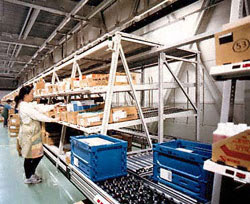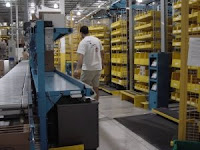A.Deep-Lane Pallet Rack
What is it and how does it work?
Pushback Rack is a reverse flow storage system which offers the same storage density as Drive-In Rack, but with much greater selectivity. This rack is also known as Reverse Gravity Rack. Pushback Rack allows for a "Last In, First Out" (LIFO) rotation inventory management system as well as a reduction in the number of fork truck aisles needed in your warehouse. This translates into increased productivity, efficiency (time savings) and optimizes your existing space. Loads/pallets are stored and retrieved from the aisle. Loads in each pushback rack lane rest on a cart, which sits atop a rail that slopes gently toward the front (towards the aisle). When a new load/pallet is deposited onto a cart within a lane by a forklift, it "pushes back" the one already at the face as well as those behind it. Depending how "deep" (2 deep to 6 deep) the rack is will determine how many pallets can be stored in that individual lane. Then, when a load/pallet is picked from the face of the rack or lane, the contents of the lane all move gently forward (at a controlled and slow speed) with a new pallet coming to the face, replacing the one just removed. This new pallet (which moved forward) is now also ready to be picked, or another pallet can be added ("pushed back") to fill the lane again.

Applications:
Ideally suited for storing a large quantity of relatively few SKUs; especially effective when one SKU is assigned per bay.
Works best in warehouses with 15 to 30 ft. ceiling clear heights.
Key Benefits
a. -High density - there is theoretically no limit to depth- systems of 20 pallets deep and more have been installed.
b. - Throughput - can keep pace with high volume palletizers, and other production lines.
c. -Productivity - eliminates lift truck travel time - pallet flow lanes do the conveying.
B. Flow Rack
What is it and how does it work?
Flow rack is a gravity flow storage system that provides a low cost and highly efficient first-in/first-out storage solution. Flow racks can be used both for cartons and pallets. Flow rack is one of the fastest options available for piece and/or carton picking. Full pallets can also be picked from flow racks.

Forward pick operations.
SKUs with high pick activity.
FIFO picking.
Full and split-carton picking.
Secondary carton and pallet storage

The Advantages of Flow Rack Systems:
1. First-in, first-out (FIFO) inventory control.
Loads are transported, via the flow rails from the loading end to the unloading end of the storage system. The first load in is always the first load to be taken out. This constant stock rotation is especially beneficial with perishable or time-sensitive goods, such as food or pharmaceuticals, where a lost product becomes a lost profit.
2.Reduced handling costs.
Once loaded, product rotation is automatic. The SK3400 rack eliminates labor and fork truck operation to rearrange loads. And Steel King flow rails are powered by gravity, requiring no electricity or other utilities.
3.Reduced handling equipment costs.
Fork lifts are required only for the initial loading and final unloading. Because only two aisles are necessary, aisle space can be reduced by 75 percent. Fewer fork lifts, operating fewer hours, and consuming less fuel can accomplish the same handling function.
4.Time and labor savings.
With only two aisles, each dedicated to specific functions (loading or unloading), traffic is more orderly, employees are more efficient and overall productivity is improved.
5.Space savings.
Because storage density can be doubled, storage capacity can be increased within the same storage area, or a portion of your existing storage area can be made available for other uses.
6.Construction cost savings.
By increasing storage capacity within existing facilities, the need for new construction could be eliminated. When new construction is necessary, building size and cost can be reduced by up to 50 percent. A smaller warehousing area, in turn, can reduce insurance, land acquisition costs, and taxes.
7.Operating expense reduction.
Higher density storage and consequently smaller storage areas also mean less area to heat, illuminate, air condition, and/or refrigerate.
8.Decreased fork lift damage.
Decreased fork lift handling of loads can result in less product damage and less potential for collision damage to the rack structure.
9.Flexibility.
Flow storage systems have been successfully installed as a part of virtually every storage function, including raw materials receiving and storage, work-in-process, buffer storage, finished goods, order picking, and cross docking
C. Vertical/Horizontal Carousel
What is that and how does it work?
Horizontal/vertical carousels are high-density storage devices designed to use vertical storage space and increase the ease and accuracy of order/parts picking. Carousels operate by moving bins along a horizontal or vertical axis. The operator remains at a fixed input/output location while the designated load travels to the operator. Loads can be tracked with an inventory management system. Carousels are offered in many standard sizes or can be customized as required. Although generally used for lighter loads (less than 50 pounds per bin), custom designed carousels can handle loads up to 2,000 pounds. Horizontal carousels are available with up to 100 bins with an overall length of 60 feet. Vertical carousels are available with heights up to 25 feet.

Applications:
Forward pick operations.
JIT buffer storage.
Work in process storage.
Small part sorting.
Secure storage.
Finished goods storage.
Advantages:
1.High-density storage.
2.Accommodates a variety of tote and product sizes.
3.Simple controls.
4. Accurate order/part picking.
5 Eliminates walk and search time.
6 . Improved ergonomics and operator safety.
7. Efficient use of storage space.
8. Eliminates bending or stretching to retrieve parts.
9. Provides a secure storage area.
10. Conventional Pallet Rack : -Conventional pallet rack is one of the most affordable types of storage for palletized products. It is relatively easy to modify its location and adjust tier heights as storage requirements change. Conventional pallet racking also allows storage of a wide variety of load footprints in the same rack.
. Shelving
What is it and how does it work?
shelves for product storage is an economical and versatile storage method that is easily modified as requirements change. The vertical height of shelving is usually below six feet but may go up to 15 feet high if movable stairs are to be used for picking product from the higher shelves. Shelving works well with Warehouse Management Systems (WMS) and picking carts.
Applications
1.Forward pick operations.
Primarily for storage of relatively small raw materials and finished goods.
2.Works best in warehouses with 8 to 15 foot ceiling clear heights
.
Advantages
diagnostic tests are:
· Easy to use, with minimal training
required.
· Relatively rapid; same-day results are
possible, resulting in fewer patients lost
to follow-up.
· A shelf life as long as 1-2 years at
ambient temperatures, with no need for
refrigeration.
· Limited or no need for instrumentation,
allowing these tests to be performed at
the periphery of health systems, often
where there is no laboratory or
electricity.
· In some cases, rapid tests are more
accurate than existing reference-level
laboratory tests.
Some general disadvantages of rapid tests are:
· Cost per test for rapid tests may exceed
traditional testing methods such as
microscopy.
· Most rapid tests have limited shelf lives
that place increased demands on
procurement and distribution systems.
· They are mainly qualitative, producing
only "yes/no" answers that may yield
less information than the existing
laboratory-based quantitative tests.
· They require subjective interpretation,
which may result in reader variation in
results.

